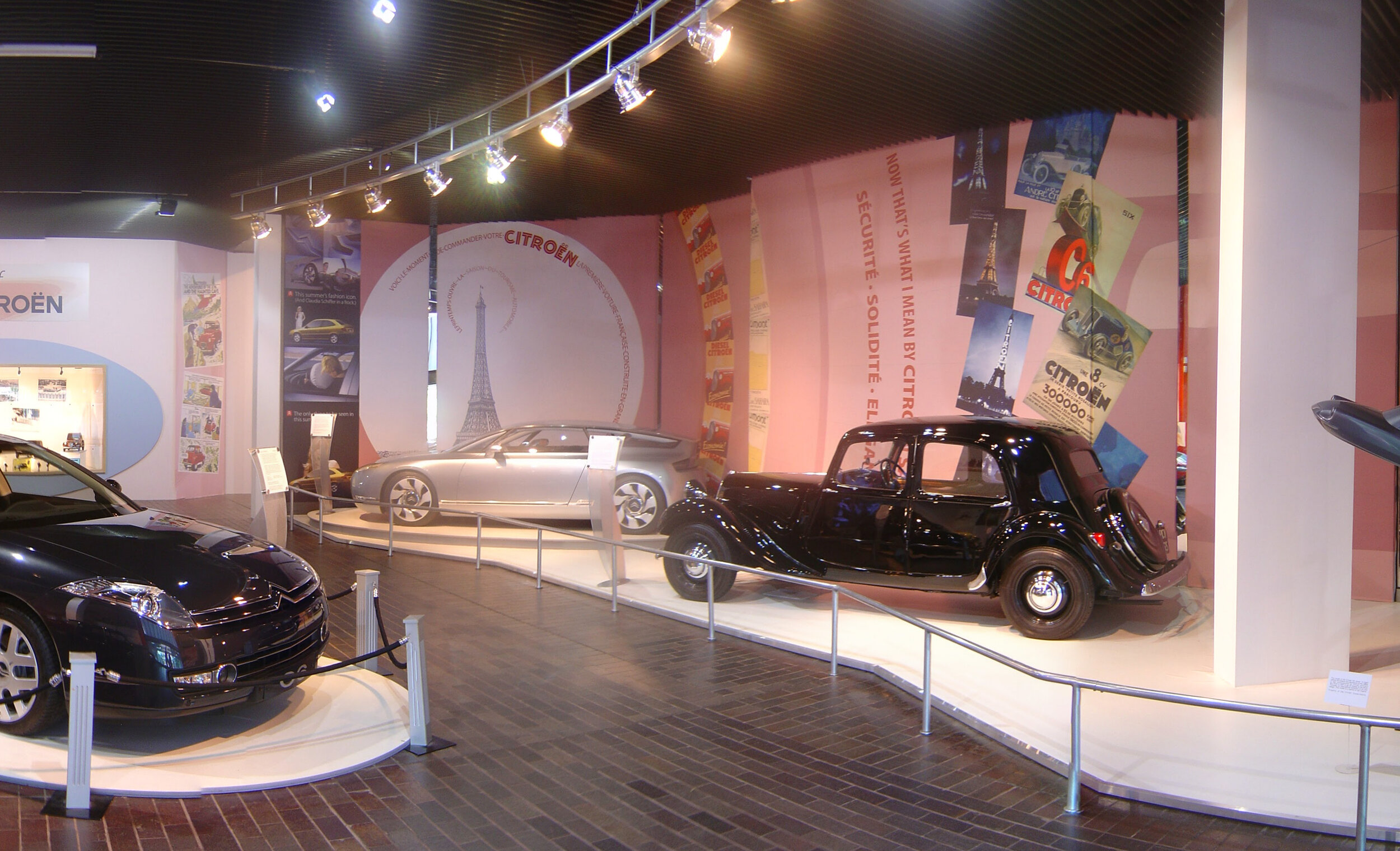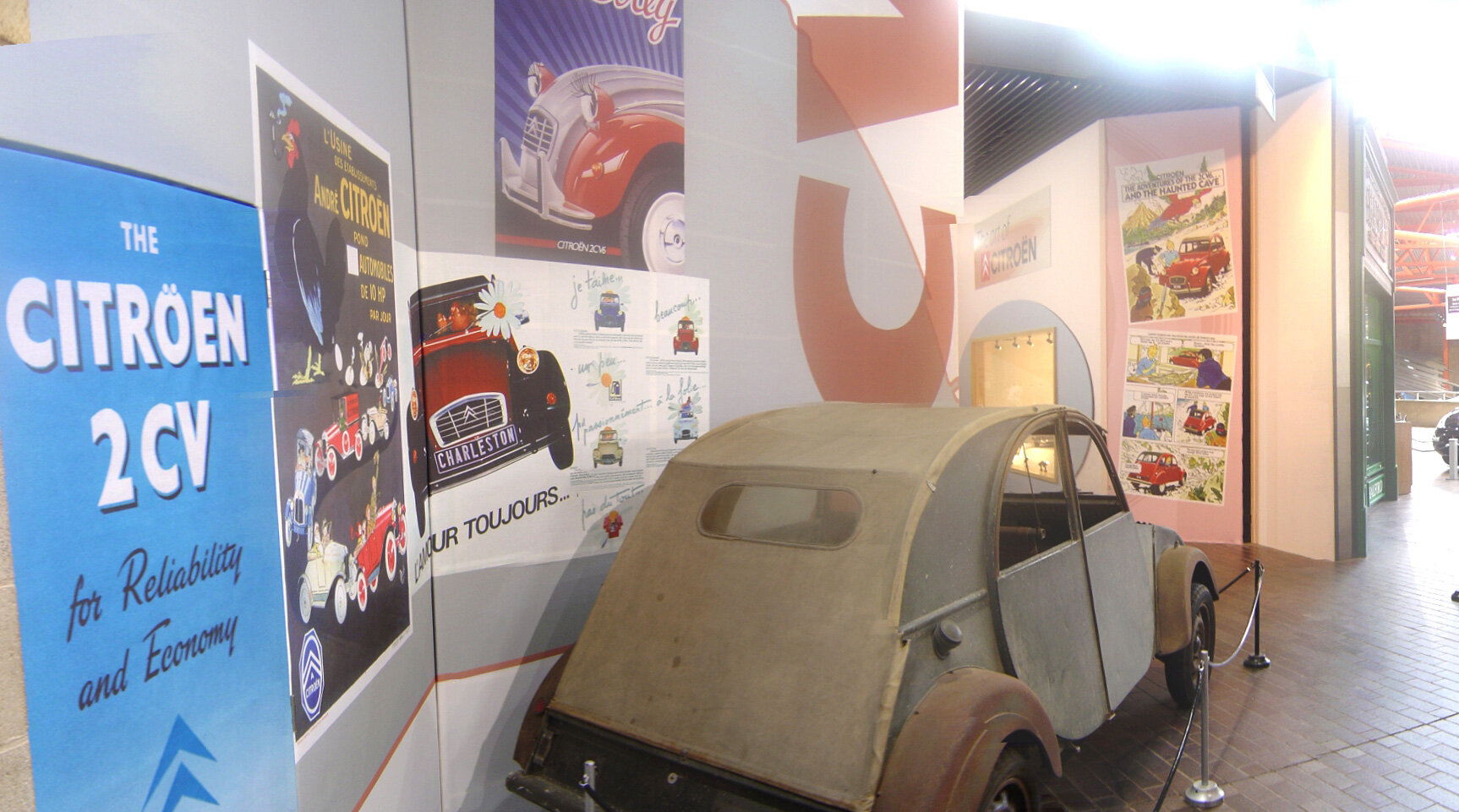The Art of Citroën










The Art of Citroën, was a special exhibition at the National Motor Museum, Beaulieu, in collaboration with the Citroën Conservatoire in Paris showcasing the history of Citroën, to the present day. The display was carefully crafted to realise the potential of the brief while keeping in mind the technical and budgetary requirements.
I was part of a three person team on the project. My primary role was to design the graphic backdrops for the exhibition, which were essential story telling elements for the exhibit’s theme.
Museum referee: Steve Lanham, Exhibitions Officer, National Motor Museum, Beaulieu
Workshop Drawings
Because we are already working to scale in 3D during the concept phase, the transition to fully detailed workshop drawings is an easy one. With these, contractors can very accurately quantify materials and costs.
Client review points
Built into all our projects is a process of client review. It’s very important for everybody that there be no surprises in a project. Regular client review at project milestones ensures that good communication happens.
Program of Build
Prototype 2CV
In the technical delivery phase of a project it is very important to have a clear idea of the critical path. Being aware of project element dependencies is vital for a high quality exhibit to be opened on time and on budget. For example In the case of The Art of Citroën, it was necessary to give the large format digital printing used for the backdrop to the show, sufficient time to dry before transporting to site. This meant the artwork for the printing had to be complete weeks before the show opened. The backdrops were installed on a timber framework as the first part of the build. Another level of complication to the on-site build was the museum remained open throughout. temporary structures were erected to allow the public access to the Museum safely compartmentalised from the work.
Onsite supervision
In the interests of excellent results, it is very important to communicate with contractors on site. Especially if a snag is encountered. The Art of Citroën build on site went very smoothly mostly due to our accurate 3D appreciation of the space.
Object conservation
Most of the objects on display in The Art of Citroën were reasonably hardy form a conservation perspective. That is not to say visitors were encouraged to touch most of them. Barriers, tensor ropes, and a glass case were used to protect sensitive objects from the public. The two exceptions to this were the centrepiece C6 and one of the DS’ which visitors could sit in.
Artwork
The artwork created for the backdrop panels is originated primarily from archival marketing material from the Citroën Conservatoire in Paris. The scale of the walls meant that some of the original posters had to be re-worked to allow them to be reproduced with sufficient quality. The backdrops were there to cover the visually disruptive walls, but also to showcase some of the very innovative marketing carried out by Citroën, especially in it’s early years.
Tender package
Our tender package for most projects includes concept renderings, cad plans, and written analysis including budget in an A3 booklet, and a stand up presentation. For this show, we also made a physical scale model because it is such a good vehicle for conveying design intent to a group of people. Sketches, cad drawings and renderings can all be misinterpreted. It’s quite difficult to misinterpret a physical 3D model.
Once the tender has been won, we move swiftly on to client consultation and the more technical aspects of the job.
TECHNICAL:
Concept refinement
Curved wall concept
With client consultation, a phase of refining the concepts into fully detailed studies of the exhibition takes place.
Design development (rendering, card models, presentation panels)
To-scale cad plans are drawn. These are worked up into 3D renderings. The renderings and cad drawings are used to refine the concepts in an iterative process to arrive at reasonably accurate representations of the exhibition concepts.
Marketing role
As is often the case, we came up with the name of the show.
The Project
The National Motor Museum attracts Motoring enthusiasts and their families from all from all over the world. They also attract a large number of students from the UK and Europe. Commercially the Museum is also used for functions.
Physical Environment
The entrance lobby is the primary space for changing exhibitions at the National Motor Museum. Because it’s the entrance to the museum, there is a lot of natural light, due to large windows, and a long row of glass doors. It’s a high visibility area, and creates a first impression for the Museum visitor.
Budget
Like exhibitions at most museums, The Art of Citroën had a very tight budget. Although the budget was a real constraint on the creative side of the project, we delivered a display that enhanced the museum visitor experience, and told engaging, multi-faceted stories about the marque.
The £138,000 project was funded partly by the National Motor Museum, and partly by the Citroën Conservatoire in Paris.
Lighting
lots of natural light due to the glass entrance doors and windows. The space graduates to low levels of natural light towards the back. The objects on display – cars primarily, need a certain amount of theatrical lighting to make them really pop. Hanging points for truss lighting, and lighting circuits were available.
Art Direction
We sourced images and video to support the overall ambiance of the visitor experience.
People flow
Careful consideration of people flow was required due to the siting of the exhibition primarily within the entrance lobby to the museum. Very clear delineation between exhibit space and public space. While providing clear flow for visitors heading further into the museum is important, it is also important that interstitial spaces be provided for visitors to dwell and examine the exhibition.
It was a requirement of the project to allow large groups of French school children to view the exhibition.
Air-conditioning
Heat generated by lighting, visitor numbers and AV equipment were taken into account with the building services.
Assessment of response / other considerations
Client review presentation
The intention here is to fully represent the exhibition so that all players can appreciate exactly what it will look like once complete i.e. there are no surprises.
Education material (brochure, exhibition texts, video, archival advertising material)
We researched, wrote, created artwork for and arranged printing for all the exhibition texts
The educative material included wall texts, the archival material reproduced on the backdrops, a loop video of advertising and technical explanation material, and a print brochure.
Delivery (project management)
CREATIVE:
Preliminary concept drawings
A phase of discussion around the brief and surrounding material, and concept sketches to make real the creative ideas is our usual method of proceeding with a project.
Promising ideas recorded by sketches are taken to the next phase


